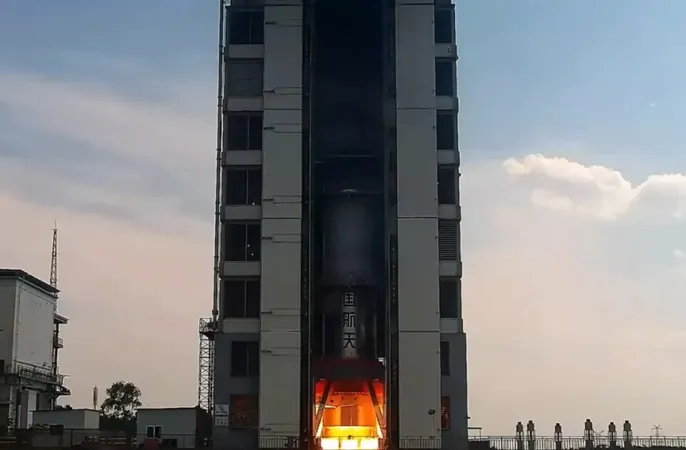
China’s Ambitious Moon Mission: New Long March 10A Rocket Set for 2026 Launch
2024-11-06
Author: Ling
China’s Ambitious Moon Mission
In an exciting development for space exploration, China has announced that its new Long March 10A rocket is slated for its inaugural flight in 2026. This launch represents a significant milestone for China's aspirations to send astronauts to the moon.
Specifications of Long March 10A Rocket
A full model of the Long March 10A, which features a single-core design tailored for carrying crew, will be showcased at the upcoming Zhuhai Airshow in southern China starting November 12. According to a report from Science and Technology Daily, the 67.4-meter-long rocket boasts a diameter of 5.0 meters and is designed to carry payloads of up to 14,200 kilograms to low Earth orbit (LEO) after an initial recovery of its first stage. For cargo missions aimed at the Tiangong space station, its length will be slightly shorter at 66.4 meters.
Broader Lunar Plans
The first launch of the Long March 10A marks a pivotal step in a broader plan that includes the development of a more powerful three-core Long March 10 rocket. This advanced rocket will be critical for China's goal of landing astronauts on the moon by 2030 and will stand at an impressive 92 meters tall, capable of delivering 27 tons into trans-lunar orbit.
Mission Details and Crew
In this upcoming lunar mission, two Long March 10 rockets will work in conjunction to transport astronauts to the moon and back. One will carry the crewed spacecraft, named Mengzhou, while the other will deliver the lunar lander, known as Lanyue. These two vehicles are designed to rendezvous in lunar orbit, allowing them to execute their mission effectively.
Astronauts' Lunar Excursion
The mission plans include a brief six-hour lunar excursion by a pair of astronauts who will then return to lunar orbit to meet up with their fellow crew member before making the journey back to Earth.
Comparison with NASA's Artemis III Mission
In contrast, NASA is eyeing a lunar return with its Artemis III mission, aiming for a 2026 launch, although there are concerns about potential delays.
Development by CALT
The China Academy of Launch Vehicle Technology (CALT), a subsidiary of the China Aerospace Science and Technology Corporation (CASC), is spearheading the development of the Long March 10 rocket. However, crafting the three-core variant will entail overcoming new engineering challenges, such as managing its enhanced size, complexity, and aerodynamic properties. This three-core configuration is novel territory for Chinese rocketry, as the nation’s current largest rocket is the 5.0-meter-diameter Long March 5.
Engineering Challenges
Additionally, the challenge of aligning and synchronizing the engines, as well as ensuring efficient landing and recovery, will be paramount in the rocket's design.
Static Fire Test Success
Back in June, CALT successfully completed a static fire test on the first stage of the Long March 10A, paving the way for future tests.
Zhuhai Airshow and Long March 9 Rocket
At the Zhuhai Airshow, enthusiasts can also expect a glimpse of the Long March 9 rocket, aimed at launching space infrastructure, including missions to the moon. Current designs suggest the Long March 9 could feature a reusable upper stage, similar to SpaceX’s Starship, highlighting China's intent to ramp up its space capabilities significantly.
Long March 9 Specifications
Recent announcements indicate that the Long March 9 could have a larger diameter of 10.6 meters and be powered by 30 YF-215 engines, targeting its first launch around 2030. This rocket will be vital for constructing the International Lunar Research Station, which China plans to commence building in the early 2030s.
Future Launches with Long March 8
In addition, the modified Long March 8 rocket is expected to make its debut flight later this year from a new commercial spaceport near the Wenchang Satellite Launch Center. This initiative demonstrates China's commitment to increasing its launch frequency and establishing its presence in the global space sector.
Conclusion
China's ambitious plans are set to reshape the landscape of space exploration, capitalizing on the momentum from their recent accomplishments and signaling a new era of human presence on the moon and beyond.




 Brasil (PT)
Brasil (PT)
 Canada (EN)
Canada (EN)
 Chile (ES)
Chile (ES)
 España (ES)
España (ES)
 France (FR)
France (FR)
 Hong Kong (EN)
Hong Kong (EN)
 Italia (IT)
Italia (IT)
 日本 (JA)
日本 (JA)
 Magyarország (HU)
Magyarország (HU)
 Norge (NO)
Norge (NO)
 Polska (PL)
Polska (PL)
 Schweiz (DE)
Schweiz (DE)
 Singapore (EN)
Singapore (EN)
 Sverige (SV)
Sverige (SV)
 Suomi (FI)
Suomi (FI)
 Türkiye (TR)
Türkiye (TR)